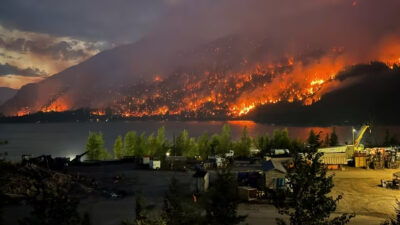The province introduced a pilot program for rebuilding waterfront homes lost In Celista during the Bush Creek fire on August 22, 2024. The name for this initiative is the 2023 WILDFIRE REBUILDING DIRECTION. The link to the 2 documents sent to landowners are Riparian Recovery – 2023 Wildfire Rebuilding Direction and Private Lands Permission Form. Essentially, owners will be able to build on their pre-existing footprint (no foundation required) but will not be able to rebuild accessory buildings that were in the SPEA. The province will hire and pay for a QEP who will coordinate the rebuilding approvals and the riparian planting. Owners are being asked to sign up for the new program which includes permission for WRLS staff to enter the property.
To put this in context, most of the 29 homes along the Celista waterfront are in the SPEA (i.e. built too close to the water) and have retaining walls that are unpermitted, some of which were built below the high water mark. Owners who are currently engaged in the hardship process in RAPR can “park” their applications and resume them later if the new direction doesn’t work out.
The provincial water management group who issue Section 11 permits to construct retaining walls have made soft commitments to the new direction; they have agreed to be flexible with regards to engineer-required retaining walls to support foundations, cannot authorize a trespass on crown land but the new direction will work internally with the lands branch in these situations, and RWM will be flexible if retaining walls are an engineer requirement for the proposed dwelling, this include make upgrades to existing retaining walls. Please note these are direct quotes from the person responsible for the new direction.
What is becoming very clear is that no hardship application will ever be approved under the current RAPR rules. WRLS claims there is no flexibility in applying RAPR but I have observed significant flexibility in interpreting the rules, but always in a more restrictive way. One owner had his application rejected 5 times and for different reasons each time. The latest was a request to move the house back a couple of feet which would require removal of the existing foundation his engineer has certified for reuse. This would add a $200,000 cost to the rebuild. In successive recalculations of hardship areas using math that as an engineer I can’t comprehend, another owner has been told by the RAPR reviewer that his property does not even meet the criteria for Hardship and is left with nowhere to build.
One can only assume that if water management are faced with applications under the RAPR hardship process, any flexibility they offer to the new direction will vanish. This is really important as it appears that in 2022, stacked rock retaining walls were not being permitted anywhere on Shuswap Lake. Instead, they are looking for 2:1 sloped rip rap or even lower gradient slopes “armoured” with coco mats and plantings. There is no room on the affected lots in Celista for these prescriptions. This is a topic for another time and is a flashback to the days of SLIPP and reports written by irresponsible environmental professionals.
So here we are, 12 months after the fire and only one RAPR assessment has been approved. The property was able to meet the 15 m SPEA setback and didn’t have a retaining wall.
I am being asked to advise owners of whether they should sign on to the new direction or not. I really don’t think there is any choice. We have been told that if owners don’t sign up, their RAPR applications will go to the bottom of the pile (and while not said, will probably stay there).
If one was a bit cynical about government, it would be easy to conclude that a significant political investment has been made in the new direction and the RAPR reviewers have been instructed to make life so miserable for owners they sign up. My concern is that this obstructionist attitude will spill over into non fire RAPR reviews for owners wanting to rebuild or expand their waterfront homes. Regardless of motivation, when I read through the reviewer’s comments on most submissions there is a lack of empathy, no urgency, and a “I’m smarter than you” sense of satisfaction in saying no.
In closing it is important to understand the CSRD’s role in this. For non waterfront properties, rebuilding is happening big time. In Scotch Creek and Celista the CSRD has issued 28 building permits with 16 more in the queue. Of the 44 permits, 37 are for single family homes. The hills above Celista are noisy with the sounds of excavators and nail guns. It’s really exciting to see people rebuilding their lives and community. The CSRD has issued no building permits on the waterfront because applications are mired in provincial process.
Acronyms
RAPR – riparian area protection regulation
SPEA – streamside protection and enhancement area = setback
WLRS – water land resource stewardship = provincial ministry responsible for RAPR
RWM – regional water management = provincial ministry responsible for Section 11’s – retaining wall approvals
SLIPP – Shuswap lake integrated planning process = now Shuswap watershed council
CSRD – Columbia Shuswap Regional District = issues building and development permits

